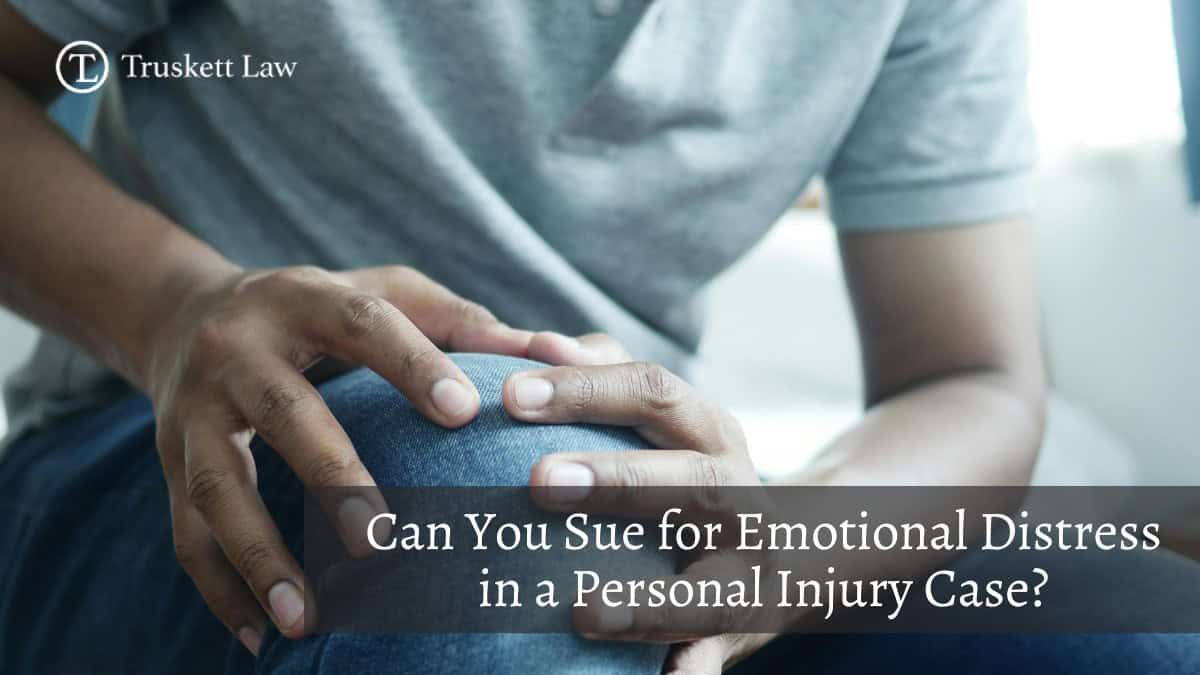
30 May Can You Sue for Emotional Distress in a Personal Injury Case?
Personal Injury Law and Emotional Distress
Emotional distress is a significant component of many personal injury cases, encompassing the psychological impact of an injury or traumatic event. While physical injuries are often visible and quantifiable, emotional distress can be more challenging to prove and quantify. Nonetheless, the legal system recognizes emotional distress as a legitimate harm for which victims may seek compensation.
Understanding Emotional Distress
Emotional distress refers to the mental suffering experienced as a result of a traumatic event or injury. This can include anxiety, depression, post-traumatic stress disorder (PTSD), and other psychological conditions. In personal injury cases, emotional distress is considered a non-economic damage, meaning it does not have a direct monetary value like medical bills or lost wages, but is nonetheless compensable.
Legal Grounds for Emotional Distress Claims
There are two primary legal theories under which a person can sue for emotional distress: intentional infliction of emotional distress (IIED) and negligent infliction of emotional distress (NIED).
Intentional Infliction of Emotional Distress (IIED)
IIED occurs when a defendant’s intentional or reckless conduct is so outrageous that it causes severe emotional distress to the victim. To succeed in an IIED claim, the plaintiff must prove:
- The defendant’s conduct was intentional or reckless.
- The conduct was extreme and outrageous.
- The conduct caused the plaintiff’s emotional distress.
- The emotional distress was severe.
For example, in cases of harassment or abuse, victims may pursue IIED claims if the perpetrator’s actions meet these criteria.
Negligent Infliction of Emotional Distress (NIED)
NIED involves situations where the defendant’s negligent behavior causes emotional distress. Traditionally, courts required a physical injury to accompany emotional distress claims. However, many jurisdictions have recognized exceptions, allowing claims for emotional distress without physical injury under certain circumstances.
One notable exception is the “bystander” rule, where a person witnesses a traumatic event, such as a loved one being injured or killed, and suffers emotional distress as a result. In such cases, courts may allow NIED claims even without direct physical harm to the plaintiff.

Proving Emotional Distress
Establishing a claim for emotional distress requires substantial evidence. Plaintiffs must demonstrate the severity and impact of their psychological suffering. Common forms of evidence include:
- Medical Records: Documentation from mental health professionals diagnosing conditions like PTSD, anxiety, or depression.
- Therapy Records: Evidence of ongoing counseling or psychiatric treatment.
- Expert Testimony: Statements from psychologists or psychiatrists attesting to the plaintiff’s mental state.
- Personal Testimony: The plaintiff’s own account of their emotional suffering.
- Witness Testimony: Statements from family, friends, or colleagues observing changes in the plaintiff’s behavior or demeanor.
The credibility and consistency of this evidence are crucial in persuading the court of the legitimacy of the emotional distress claim.
Compensation for Emotional Distress
Compensation for emotional distress falls under non-economic damages, which are inherently subjective and vary widely based on the specifics of each case. Factors influencing the amount awarded include:
- Severity of the Distress: More severe psychological impacts typically warrant higher compensation.
- Duration: Long-term or permanent emotional suffering can lead to increased damages.
- Impact on Daily Life: If the distress significantly impairs the plaintiff’s ability to work, maintain relationships, or perform daily activities, compensation may be higher.
- Jurisdictional Caps: Some states impose limits on non-economic damages, which can affect the total compensation awarded.
It’s important to note that while emotional distress damages are compensable, they are often more challenging to quantify than economic damages, necessitating thorough documentation and legal expertise.
State-Specific Considerations
Laws governing emotional distress claims vary by state. Some states have more stringent requirements or limitations. For instance, in Texas, while you can sue for emotional distress, you must meet specific legal standards. Texas courts require clear, compelling evidence that the distress was severe and directly caused by the defendant’s actions.
Plaintiffs must also demonstrate that the emotional suffering resulted in actual harm, such as medical expenses, lost income, or a diagnosed mental health condition.
Understanding the nuances of your state’s laws is essential when considering an emotional distress claim. Consulting with a knowledgeable attorney can provide clarity on your rights and the viability of your case.
If you believe you’ve suffered emotional distress as a result of someone else’s negligence or intentional actions, it’s important to understand that these claims are taken seriously in court, but they also require thorough, credible evidence. The process involves several key steps to help build a strong case and improve your chances of receiving fair compensation for your mental and emotional suffering.
Seek Immediate Medical and Psychological Care
The first and most important step is to seek medical attention or a psychological evaluation as soon as possible. Emotional distress claims rely heavily on documented evidence of your mental and emotional condition. A licensed physician, psychologist, or therapist can assess your symptoms, provide a diagnosis, and recommend a treatment plan.
This medical documentation will serve as a foundation for your claim, demonstrating both the severity and legitimacy of your emotional injuries. Even if your symptoms seem mild at first, early evaluation ensures you receive proper care and creates a medical record that can later support your case.
Document the Incident and Its Effects
Next, gather all available evidence related to the event or situation that caused your emotional distress. This can include police reports, accident reports, witness statements, photographs, video footage, and any other relevant records. These materials help establish the circumstances surrounding your claim and link the negligent or intentional actions of the responsible party to your suffering.
Identify the Responsible Party
For any legal claim, it’s essential to determine who is legally responsible for your emotional distress. This might be an individual, business, or organization, depending on the situation.
Whether it’s a reckless driver, a negligent property owner, or a company engaging in harmful practices, identifying the correct liable party allows your lawyer to file the appropriate legal actions and ensures your case is directed against the right defendant.
Understand the Legal Requirements
It’s important to note that emotional distress claims must meet specific legal requirements to be successful. Depending on your state, there may be different standards for proving negligence or intentional infliction of emotional distress.
Some jurisdictions may require physical symptoms to accompany your emotional suffering, while others accept claims based on mental anguish alone. Understanding these legal nuances is critical, and one of the reasons why working with an experienced personal injury lawyer is so important.
Work with a Personal Injury Lawyer
Navigating an emotional distress claim on your own can be overwhelming, as these cases are often complex and heavily scrutinized by insurance companies and the court. A knowledgeable personal injury lawyer can assess your case, help determine whether you meet the necessary legal criteria, and guide you through each step of the process.
They’ll assist in gathering medical records, securing expert testimony from mental health professionals, and negotiating with insurance companies on your behalf.
If your case moves to trial, having a lawyer ensures that your rights are protected and that your case is presented effectively. Emotional distress cases often involve sensitive personal details and complicated legal arguments, so having a trusted legal advocate by your side makes a significant difference.
The right lawyer will fight for the compensation you deserve — including coverage for therapy, medication, lost income, reduced quality of life, and other damages.

Stay Consistent with Treatment and Documentation
Once your claim is in progress, it’s crucial to remain consistent with your medical treatment and continue documenting your symptoms. Regular therapy sessions, follow-up doctor visits, and keeping detailed personal notes about your mental and emotional state will strengthen your case. Inconsistent treatment or gaps in care can be used by opposing parties to question the validity or severity of your emotional distress.
Maintaining open communication with your healthcare providers about your symptoms and progress also ensures that your medical records accurately reflect your ongoing condition, a vital element in proving emotional distress damages.
Conclusion
Suing for emotional distress in a personal injury case is a complex process that requires a thorough understanding of legal principles and substantial evidence. While challenging, it is possible to obtain compensation for the psychological impact of an injury or traumatic event.
If you believe you have suffered emotional distress due to someone else’s actions, it’s crucial to consult with an experienced personal injury attorney who can guide you through the legal process and advocate on your behalf. Contact our team today to discuss your situation.


Sorry, the comment form is closed at this time.